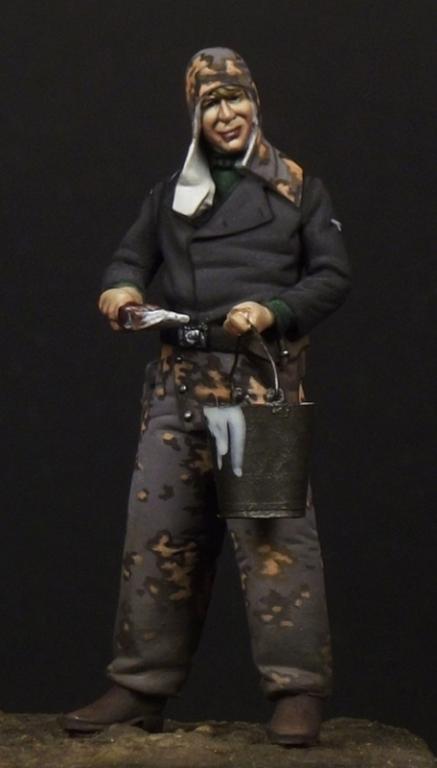
Each engine is rated at 40,440 pounds of thrust and includes thrust reversers that direct the flow of air upward and forward to avoid ingestion of dust and debris. The aircraft is powered by four Pratt & Whitney F117-PW-100 turbofan engines, which are based on the commercial Pratt and Whitney PW2040 used on the Boeing 757. The C-17 measures 174 feet long (53 meters) with a wingspan of 169 feet, 10 inches (51.75 meters). The Boeing warranty assures these figures will be met.
#Panzer crewman images full
These requirements include an aircraft mission completion success probability rate of 92 percent, only 20 aircraft maintenance man-hours per flying hour, and full and partial mission availability rates of 74.7 and 82.5 percent, respectively. Current operational requirements impose demanding reliability and maintainability. Reliability and maintainability are two outstanding benefits of the C-17 system. The C-17 is capable of meeting today's demanding airlift missions. As a result, newer and more flexible airlift aircraft are needed to meet potential armed contingencies, peacekeeping or humanitarian missions worldwide. This trend has significantly increased air mobility requirements, particularly in the area of large or heavy outsize cargo. interests have changed in recent years, and the size and weight of U.S.-mechanized firepower and equipment have grown in response to improved capabilities of potential adversaries. The ultimate measure of airlift effectiveness is the ability to rapidly project and sustain an effective combat force close to a potential battle area. The inherent flexibility and performance of the C-17 force improve the ability of the total airlift system to fulfill the worldwide air mobility requirements of the United States. The aircraft can perform tactical airlift and airdrop missions and can transport litters and ambulatory patients during aeromedical evacuations. The C-17 is capable of rapid strategic delivery of troops and all types of cargo to main operating bases or directly to forward bases in the deployment area. III Ausf.The C-17 Globemaster III is the most flexible cargo aircraft to enter the airlift force. Wreckage of a German PzKpfw III tank blown up to prevent it being recovered by the enemy In the foreground, a line-up of PzKpfw III tanks Hundreds of captured enemy armoured vehicles near El Alamein wait to be broken up for scrap metal, 16 December 1943. He is chalking a letter 'E' on the rear of the tank - denoting 'Extermination' ! Troops inspecting a German PzKpfw III tank, knocked out by a 2-pdr anti-tank gun in the Western Desert, 2 June 1942 Ī Royal Engineers officer checking the wreckage of a German PzKpfw III tank blown up to prevent it being recovered by the enemy, 31 October 1942. Posed photograph of infantry sheltering from ‘enemy shellfire’ beside a knocked-out German PzKpfw III tank, 2 November 1942 Īllied soldiers examine a destroyed Panzer, El Alamein 1942 Ī soldier examines the wreckage of a PzKpfw III tank blown up by the Royal Engineers to prevent the Germans from recovering it, October 1942 Ī disabled German PzKpfw III tank is blown up by the Royal Engineers to prevent it being recovered by the enemy, 31 October 1942 Ī soldier examines the wreckage of a PzKpfw III tank blown up by the Royal Engineers to prevent the Germans from recovering it, October 1942 Ī British soldier inspects the grave of a German tank crewman, killed when his PzKpfw III tank was knocked out in the Western Desert, 29 September 1942 German Panzer III tank destroyed during the Second Battle of El Alamein near El Aqquqir, Egypt. November 1942 Ĭonfrontation: A German Panzer III crewman lifts his hands in surrender to an advancing British soldier during the battle of El Alamein A total of 17 German tanks were attacking Ī captured German Panzer Mk III tank, North Africa, 1942 Two of seven German Panzer III destroyed by an Australian anti-tank battery near Tel el Eisa on 5 October 1942. Knocked out Panzer III near El Alamein, 16 September 1942 Ī side view of a long gunned Panzer III armed abandoned in the desert close to El Alamein

A small hole slightly above and between the 2nd and 3rd wheels from the right was where the effective shell entered

It could be fitted with either a 37 mm or 50 mm cannon.Ī German Panzer III Ausf.L that was knocked out by Australian anti-tank gunners at El Alamein in August 1942.

Fast and manoeuvrable it was well suited to the desert conditions. Throughout the campaign in North Africa, especially during 19, the Mark III was the German Army’s main strike weapon.


 0 kommentar(er)
0 kommentar(er)
